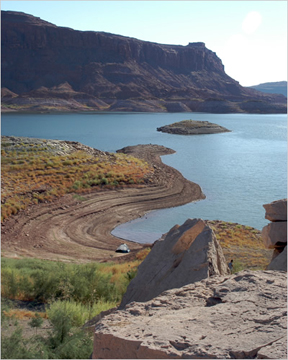There is plenty of environmentally-minded art these days, but very few academic classes on the subject, let alone degree programs. That changed this fall when the University of New Mexico launched Art and Ecology as an outgrowth of its ten-year old program, Land Arts of the American West. In its first year, the program already includes one graduate student, dozens of undergrads and two full-time professors. UNM Art and Ecology professor Catherine Page Harris spoke with me about how the program started, its relationship with other programs at UNM, and the future of ecological art.
Matthias Merkel Hess: Was the creation of the program driven by student demand or by the faculty?
Catherine Page Harris: Art and Ecology at UNM started as a response to the needs of students who were enrolling in the Land Arts program, but didn’t have a background in ecological concerns, or in the work of ecological artists. The program’s chair, Bill Gilbert, was leading these 50-day trips and found that students needed a lot of knowledge that just wasn’t readily available. He was interested in helping them expand the experience and worked closely with former sculpture professor Basia Irland to create an early curriculum.
MMH: Are there other schools that have similar Art and Ecology programs?
CPH: The only other school I know of with an Art and Ecology program is in Falmouth, England. There was one at Dartington, England, but at the moment, I think they are no longer accepting students. A similar program is starting at West Virginia University.
MMH: In an August 2008 greenmuseum blog post, Saving Eco-Art From Death by Cliché, the writer noted that “…even at greenmuseum.org we see a lot of art that is planet-devoted but aesthetically uninspiring and unoriginal.” How do you encourage students to make work that does more than simply re-state known environmental concerns and is also worth looking at and thinking about?
CPH: Well, as a pedagogical strategy, I believe in an old modernist’s statement. Stravinsky wrote in his book, Poetics of Music in the Form of Six Lessons, “The more art is limited, the more it is free.” He is talking about his own choices to create a structure for himself with the 12-tone system. As I teach, I encourage students to create parameters so they no longer have to be overwhelmed by all the choices available. We also look at published work and discuss it in all contexts, aesthetic, political, emotional.
MMH: Does your program collaborate with other departments at the university, such as ecology or history?
CPH: Right now, we have a collaboration with the UNM’s Sevilleta Long Term Ecological Research site that is proving very fruitful, with them funding a summer program at the research station for two art undergraduates. I am also working with the Sustainable Studies Program and an environmental law professor. We also have strong ties with both landscape architecture and architecture, since I was an adjunct there for three years and, as our student body grows, we are planning cross-disciplinary courses with them.
MMH: It seems to me that contemporary art is one of the least effective ways to be an activist or to change the world. What role do you see your students having both within the art world and in society?
CPH: My father, a corporate lawyer, started an environmental law firm, which has grown to be EarthJustice. He would say we need all forms of engagement. He practiced in his own manner to save the earth, but he was grateful for all kinds of expression. I think you can’t measure varying degrees of effectiveness. My father has saved more land than I ever will, but my work might be the thing that speaks to the next Al Gore, who then makes the next Nobel Prize winning gesture. You just don’t know. I think contemporary art is a conversation that sometimes leaks out to the larger world. We have created a program which redefines contemporary art as being sited IN the larger world. My spring studio course consists of three client-based projects. We will work with the Albuquerque Metropolitan Flood Control Agency, with a local agency promoting walkability to fight obesity and with the Bosque Environmental Monitoring Program, working with bats in the Bosque. Students will be making work collaboratively with these organizations, some of which will be installed on site.
MMH: We seemed to have reached a point where basic environmental concerns are on the minds of every American. What role do you see for ecological art in the future and what are some directions that artists should address?
CH: Food and water. Climate change. The basics are a good place to start. If our program is a good bellwether, I think in the future, ecological art will become part of our common vocabulary. We seek to train people who will be effective interdisciplinary artists, working in teams and able to contribute to all kinds of public and private processes. We seek an expanded role, beyond the confines of galleries or art publications. The Sandoval County Flood Control Agency, here in New Mexico, hired two artists to help them with their next several large flood control projects. I am inspired by the example of Mary Miss and her proposals for water treatment and exposing infrastructure. This can be a tremendous sea change for contemporary art and for the role of the artist.
Matthias Merkel Hess is an artist and author of Eco Art Blog.




Pingback: Check me out at the Art 21 Blog : The Center for Sustainable Practice in the Arts
Pingback: News Room :: Check me out at the Art 21 Blog
Pingback: What’s Cookin at the Art21 Blog: A Weekly Index | Art21 Blog